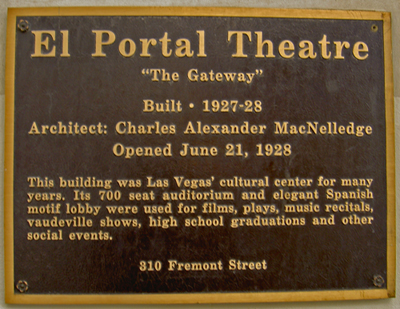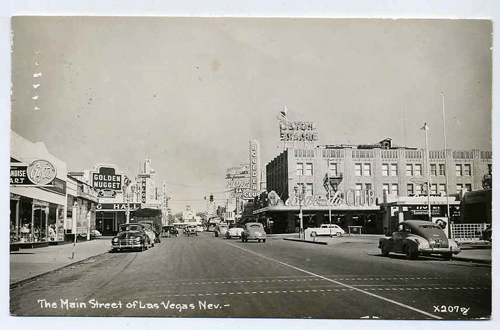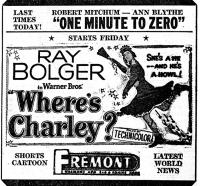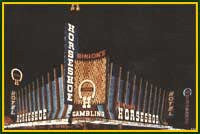North Side of the Street
Fourth to Fifth (Las Vegas Blvd South), the El Cortez and Honorable Mentions
Where Neonopolis is today used to be a thriving business community. On the corner across from Trader Bill's was one of the favorite hang-outs of teenagers in the 1950s. Corey's Restaurant. Locally owned, Corey's served up hamburgers, fries and milk shakes as well as the usual steak dinners. Next door was everyone's favorite department store, Ronzoni's.
Corey's Restaurant with Helldorado horses
Ronzoni's
Ronzoni's had originally been located up on Second Street (now Casino Center) and Fremont but with the expanding saloons and gaming joints, moved further east and expanded their store. Owned and operated by the Ronzoni family, they had come down from Tonopah where the matriarch of the family had supplied the miners in Tonopah with clothes and supplies. When business in Tonopah began to wane, she packed up the family and believing that Las Vegas was the next boom town, headed south. Ronzoni's had everything. When I was a kid, that's where you went to get back to school clothes, they would x-ray your feet to see how much they had grown and fit you for a new pair of shoes. Above all else, they prided themselves on customer service.
Woolworth's
On the corner of Fifth and Fremont was Woolworth's. With it's shiny wraparound Streamline Moderne front proclaiming 5, 10 and 25 cents and its name in the terrazo sidewalk at the ront door, it was a beauty to behold as it anchored the corner. It had a soda fountain and grill inside where many a youngster could be found twirling on the bar seats enjoying a frosty root beer float. It opened in 1948 and stood proudly on that corner for almost fifty years. In 1968, with the changing face of Fremont Street giving way to more gambling and less family oriented business, Woolworth's opened a store in the Boulevard Mall. That store finally closed in 1997 when the chain closed the remaining Woolworth's around the country.
El Cortez
On the corner of Sixth and Fremont sits the El Cortez. It's brick facade dates back to 1941 when J. Kell Houssels,Sr built the small casino with 59 rooms. When Bugsy Siegel finally made that long drive up the highway in the early 1940s, it was not to have a fever dream about building a carpet joint on the Strip but to muscle his way into the race wire at the El Cortez. But the Hollywood story sounds better no doubt. Siegel finally got his hands on the El Cortez when Houssels sold the property to him in 1946. Renowned Southern California architect, Wayne McAllister did the remodel on the El Cortez in 1946. In 1963, young Jackie Gaughan, who had come to Las Vegas in 1943 when he was stationed at the old Air Base (that would become Nellis). He moved his wife Roberta and two sons, Michael and Jackie, jr to Las Vegas in 1951. He bought a small 3% of the Boulder Club and 3% of the Flamingo with partner Eddie Barrick. Jackie had a knack for sports books and handicapping. In 1961, he and partner Mel Exber bought the Las Vegas Club and in 1963, they bought the El Cortez. Gaughan hired Wayne McAllister to oversee the design and construction of a new room tower.
Jackie invented the Fun Book, filled with coupons for free drinks, free slot pulls and two for one dinners. Like Benny Binion, he had a knack for understanding and treating his customers like kings.
Today, the El Cortez still stands and is still owned by Jackie Gaughan and his family. Gaughan lives on the 15th floor. He still goes into the offic everyday and can often be seen talking with guests and can usually be found at one of the poker tables betting with his customers.
The El Cortez is one of the favorite spots of the CheapoVegas/Big Empire crowd and they are holding their annual Soiree at the El Cortez this June.
Buy Chris Nichol's new book on Architect Wayne McAllister
McAllister Book
El Cortez in the 1940s
El Cortez in the 1950s
El Cortez roof sign
El Cortez today at night
Jackie Gaughan as airman in the Air Force
Jackie's Funbook
Honorable Mentions
Rancho Market
The Rancho Market on Fifth Street (Las Vegas Blvd) which was an operating market from the late 1940s until it was torn down for Neonopolis.
Rancho Market
World's Largest Watch Display
Not for what it is today but because of the pole. On that pole used to revolve a three-sided sign for the Horseshoe, the Fremont and the Golden Nugget.
Fremont Medical Center
This was the second location of JC Penney's. The Catalogue Pick Up and Elevator entrance was on 6th Street across the street from the El Cortez. It had all glass windows that fronted on Fremont Street. A couple of the windows broke during one of the above ground Atomic Tests in the 1950s.
The Former JC Penney's - today the Fremont Medical Center
The former entrance to Catalogue Pick-Up and the elevator entrance
Special thanks to Allen Sandquist, Cheapo Vegas, Chris Nichols and LA Time Machines.


































